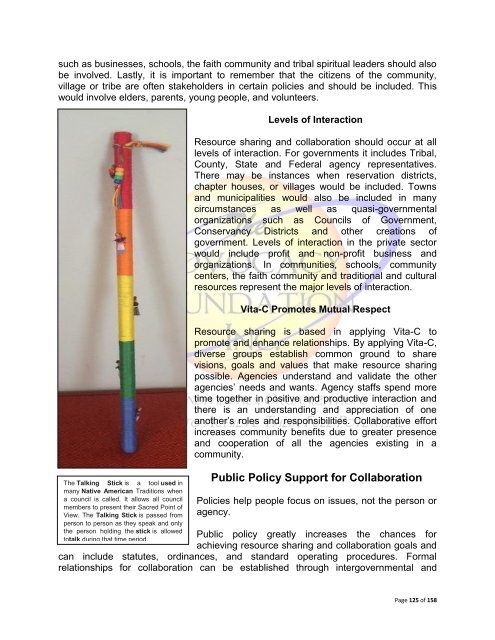Native American Youth In The Juvenile Justice System
Native American Youth In The Juvenile Justice System
Native American Youth In The Juvenile Justice System
Create successful ePaper yourself
Turn your PDF publications into a flip-book with our unique Google optimized e-Paper software.
such as businesses, schools, the faith community and tribal spiritual leaders should also<br />
be involved. Lastly, it is important to remember that the citizens of the community,<br />
village or tribe are often stakeholders in certain policies and should be included. This<br />
would involve elders, parents, young people, and volunteers.<br />
<strong>The</strong> Talking Stick is a tool used in<br />
many <strong>Native</strong> <strong>American</strong> Traditions when<br />
a council is called. It allows all council<br />
members to present their Sacred Point of<br />
View. <strong>The</strong> Talking Stick is passed from<br />
person to person as they speak and only<br />
the person holding the stick is allowed<br />
totalk during that time period.<br />
Levels of <strong>In</strong>teraction<br />
Resource sharing and collaboration should occur at all<br />
levels of interaction. For governments it includes Tribal,<br />
County, State and Federal agency representatives.<br />
<strong>The</strong>re may be instances when reservation districts,<br />
chapter houses, or villages would be included. Towns<br />
and municipalities would also be included in many<br />
circumstances as well as quasi-governmental<br />
organizations such as Councils of Government,<br />
Conservancy Districts and other creations of<br />
government. Levels of interaction in the private sector<br />
would include profit and non-profit business and<br />
organizations. <strong>In</strong> communities, schools, community<br />
centers, the faith community and traditional and cultural<br />
resources represent the major levels of interaction.<br />
Vita-C Promotes Mutual Respect<br />
Resource sharing is based in applying Vita-C to<br />
promote and enhance relationships. By applying Vita-C,<br />
diverse groups establish common ground to share<br />
visions, goals and values that make resource sharing<br />
possible. Agencies understand and validate the other<br />
agencies’ needs and wants. Agency staffs spend more<br />
time together in positive and productive interaction and<br />
there is an understanding and appreciation of one<br />
another’s roles and responsibilities. Collaborative effort<br />
increases community benefits due to greater presence<br />
and cooperation of all the agencies existing in a<br />
community.<br />
Public Policy Support for Collaboration<br />
Policies help people focus on issues, not the person or<br />
agency.<br />
Public policy greatly increases the chances for<br />
achieving resource sharing and collaboration goals and<br />
can include statutes, ordinances, and standard operating procedures. Formal<br />
relationships for collaboration can be established through intergovernmental and<br />
Page 125 of 158

















